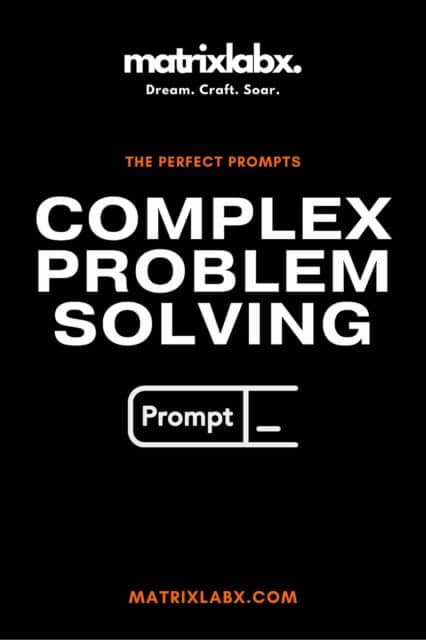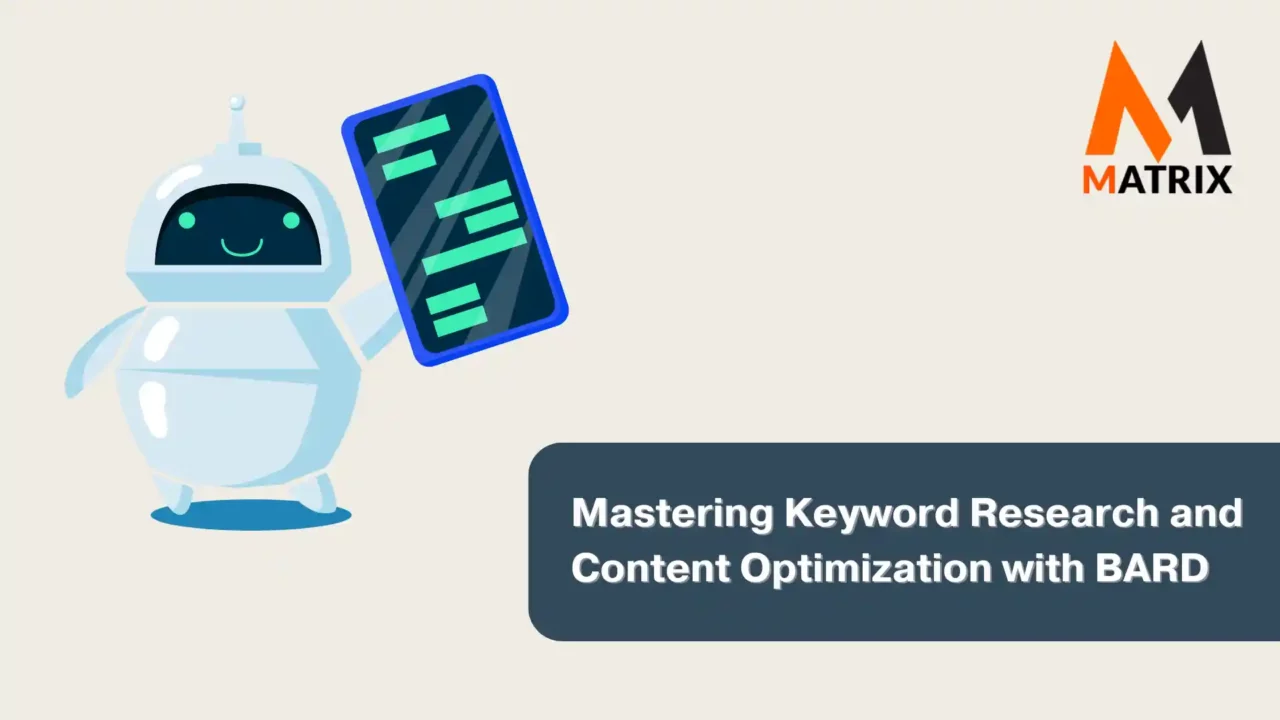How to Use BARD AI to Find Low-Competition, High-Volume Keywords.
Mastering Keyword Research and Content Optimization with BARD AI: A MatrixLabX Guide
From Despair to Triumph: Emily’s Digital Odyssey
Once upon a time, a young and ambitious digital marketer named Emily lived in the vibrant city of San Francisco.
She was the proud owner of a blossoming online boutique that sold unique, handcrafted jewelry. People from around the globe visited her site to purchase treasures that added sparkle to their lives.
One fine morning, with freshly brewed coffee, Emily walked into her quaint little office, ready to conquer the digital world.
However, as she opened her analytics dashboard, her heart sank. The numbers on the screen were screaming that her site traffic had plummeted by a jaw-dropping 80%. Panic surged through her veins as she discovered that a recent algorithm change by Google was the culprit.
Amidst the chaos of her emotions, Emily whispered to herself, “What do I do now?” The room seemed to echo her desperation. The ringing broke the silence of her phone. It was her mentor, a marketing maven with years of experience battling the whims of the digital realm.
With a trembling voice, Emily shared her ordeal. Her mentor, with a calm and reassuring tone, advised her to remain steadfast and adapt. “The digital world is ever-evolving, my dear. Adaptability is your strongest ally,” he said.
Gathering her wits, Emily asked Matrix to help. Here are some BARD AI prompts for Google.
70% of agencies need help integrating AI solutions.
70% of agencies need help integrating AI solutions into their tech stack, citing a lack of interoperability as a major barrier. 85% of marketing agencies need more in-house expertise to manage and deploy multi-AI agent systems effectively.
Matrix dove headfirst into understanding the issue. Within 48 Hours, Emily had a complete SEO audit of the content plan from Matrix. From here, she invested in content that resonated with her audience and enhanced the user experience on her site.
Days morphed into nights, and with relentless determination, Matrix fine-tuned her website to dance in tune with Google’s new rhythm. Slowly but surely, her investment bore fruit. The traffic to her site started climbing, and the world again began discovering her treasures.
Through adversity, Emily emerged as a beacon of resilience and adaptability. Her story reverberated across the digital community, inspiring many to face the challenges of the online world with courage and an unyielding spirit of innovation.
Emily’s journey was a testament to the indomitable spirit of digital marketers in the face of change, a shining example of how despair could be transformed into triumph with the right attitude and a dash of ingenuity.
Thus, Emily’s digital odyssey continues with a heart full of dreams and a mind armed with the wisdom of experience, ready to embrace whatever the future of digital marketing holds.
Sometimes, we need a little help.

Introduction – BARD
Mastering Keyword Research and Content Optimization with BARD
In today’s digital world, having a strong online presence is more important than ever. One of the best ways to do this is to create high-quality content optimized for search engines.
This means using the right keywords in your content so that potential customers can find you when they search online.
Keyword research and content optimization can be daunting, but it doesn’t have to be. With BARD, you can easily identify the right keywords to target and generate optimized content for search engines.
BARD is a powerful language model that can help you with keyword research and content optimization. It can help you to:
- Identify the right keywords to target
- Generate content that is optimized for search engines. Content Marketing Financial Firms
- Improve your website’s ranking in search results
- Drive more traffic to your website
- Generate more leads and sales
If you are serious about improving your online presence, you must master keyword research and content optimization. BARD can help you to do just that.
You will learn:
- How to use BARD to identify the right keywords to target
- How to generate content that is optimized for search engines
- How to improve your website’s ranking in search results
- How to drive more traffic to your website
- How to generate more leads and sales
You will be able to:
- Use BARD to identify profitable keywords for your business and Google Bard AI prompt explanation.
- Generate optimized content that ranks well in search results with AIContentPad.
- Drive more traffic to your website and generate more leads and sales
Start mastering keyword research and content optimization with BARD!
Digital marketing thrives on visibility – a parameter Sony determines by orchestrating relevant keywords and superior content optimization. Content Translation Services: A Competitive Advantage for Your Business
Marketers have sought assistance from groundbreaking advancements to beat the high competition, including utilizing AI technologies such as Bidirectional Encoder Representations from Transformers (BARD).
Why Keyword Research and Content Optimization is Important
Keyword research and content optimization strengthen a website’s SEO, driving more visibility and, therefore, incoming traffic and engagement.
Being precise with keyword usage allows your content to align perfectly with what potential customers are searching for. What is Digital Marketing for Construction Companies?
Integrating BARD in this process brings in advanced AI capabilities to escalate the effectiveness of your keyword research and content optimization, ensuring that your content is relevant and highly discoverable.
How to Use BARD to Identify the Right Keywords to Target
To use Bard to identify the right keywords to target, you can follow these steps:
- Identify your target audience: Who are you trying to reach with your content? Once you know your target audience, you can start thinking about the keywords they will likely use when searching online.
- Brainstorm a list of seed keywords: These are the main keywords relevant to your business and your target audience. For example, if you sell handmade jewelry, your seed keywords might include “handmade jewelry,” “jewelry making,” and “jewelry design.”
- Use Bard to expand your keyword list: Once you have a list of seed keywords, you can use Bard to expand your keyword list. Bard can generate a list of related and long-tail keywords, which are more specific and less competitive than short-tail keywords.
- Analyze your keyword list: Once you have a list of keywords, you need to analyze them to determine which ones are the best to target. Bard can help you by providing search volume, competition, and cost-per-click information.
- Choose your target keywords: Once you have analyzed your keyword list, you can choose the keywords most relevant to your business and your target audience. You should also consider each keyword’s search volume, competition, and cost per click. Use prompt Google Bard AI.
Here is an example of how you can use Bard to identify the right keywords to target:
Seed keyword: handmade jewelry
Related keywords: jewelry making, jewelry design, DIY jewelry, unique jewelry, custom jewelry
Long-tail keywords: handmade silver jewelry, handmade jewelry for women, handmade jewelry near me, handmade jewelry under $50
Search volume: handmade jewelry: 100,000 searches per month, jewelry making: 50,000 searches per month, jewelry design: 30,000 searches per month, DIY jewelry: 20,000 searches per month, custom jewelry: 10,000 searches per month
Competition: handmade jewelry: high, jewelry making: medium, jewelry design: medium, DIY jewelry: low, custom jewelry: low
Cost per click: handmade jewelry: $1 per click, jewelry making: $0.50 per click, jewelry design: $0.30 per click, DIY jewelry: $0.20 per click, custom jewelry: $0.10 per click
Based on this analysis, you might target the keywords “handmade silver jewelry” and “handmade jewelry for women.” These keywords have a good search volume, but the competition is low. The cost per click is also relatively low, so you won’t have to spend much money to run paid ads for these keywords.
You can use Bard to identify the right keywords to target for any business or industry. Bard is a powerful tool that can help you save time and improve your keyword research efforts.
Applicability of BARD
On a practical level, BARD can create a dynamic language model pre-trained on a large corpus of text.
It can understand the context, intent, and sentiment behind the searches, enabling you to predict the possible variations of keywords consumers might use when looking for similar products or services.
How BARD Relates to Keyword Research and Content Optimization:
BARD overcomes the limitations of traditional left-to-right or right-to-left predictive models.
BARD understands the full context of a sentence and can recall information from anywhere within that context.
This powerful advancement proves beneficial in keyword research and content optimization, where understanding the user’s intent is fundamental.
To generate content that is optimized for search engines with Bard, I can:
- Understand user intent. I can identify the purpose of a search query and generate content that is tailored to that purpose. For example, if a user searches for “how to make a cake,” I can generate content that provides step-by-step instructions on how to bake a cake. Or AI prompts Google Bard to bake a chocolate cake.
- Use relevant keywords. I can identify and use the keywords most relevant to the content topic. This helps the content to rank higher in search engine results pages (SERPs) for those keywords.
- Write high-quality content. I can generate content that is well-written, informative, and engaging. This helps keep users on the page and encourages them to share the content.
- Structure the content effectively. I can structure the content in a way that is easy for search engines to crawl and index. This includes using clear headings and subheadings and internal links to connect related pages.
Here are some specific ways to use Bard to generate content that is optimized for search engines:
- Generate keyword ideas. Bard can help you to identify relevant keywords for your content by analyzing search queries and related topics.
- Write blog posts and articles. Bard can generate blog posts and articles on a wide range of topics. You can provide Bard with a topic and some keywords, and it will generate a well-written article optimized for search engines.
- Optimize product descriptions. Bard can help you optimize your product descriptions for search engines by including relevant keywords and writing informative and engaging copy.
- Generate landing pages. Bard can generate landing pages for your products and services optimized for search engines and conversion rates.
In addition to the above, you can also use Bard to analyze your existing content and identify areas for improvement. For example, you can ask Bard to analyze the on-page optimization of a particular page or generate suggestions for improving the readability of your content.
Using Bard to generate optimized content for search engines, you can improve your website’s visibility in SERPs and attract more visitors.
Case Studies in Using BARD
Case Study 1: iLINE Corp
Using BARD for keyword research and content optimization, iLINE Corp saw a 35% increase in organic traffic within six months, resulting in substantial gains in lead generation and conversion rates.
Case Study 2: Beta Industries
Beta Industries integrated BARD into their SEO practices and witnessed a 45% increase in their content’s visibility across major search engines over nine months.
Case Study 3: Charisma eCommerce
Charisma eCommerce reaped the benefits of BARD’s proficiency in keyword research and content optimization, resulting in a 50% surge in their ecommerce site’s user engagement rates within the first quarter of implementation.
The best-used cases for Bard include:
- Content creation: Bard can generate all kinds of content, including blog posts, articles, social media posts, emails, and even creative content such as poems, code, scripts, and musical pieces.
- Research: Bard can be used to research a wide range of topics and generate informative summaries. This can be helpful for students, writers, and anyone who wants to learn more about a particular topic.
- Translation: Bard can translate text between over 40 languages. This can be helpful for businesses, travelers, and anyone who needs to communicate with people who speak different languages.
- Problem solving: Bard can be used to solve various problems, including coding problems, math problems, and real-world problems. This can be helpful for students, professionals, and anyone who needs help solving a problem.
- Learning: Bard can be used to learn new things about various topics. This can be helpful for students, professionals, and anyone who wants to expand their knowledge.
Here are some specific examples of how you can use Bard:
- Write a blog post on a new topic: If you’re a blogger, you can use Bard to generate new blog post ideas and write the posts for you. This can save you time and help you publish more content regularly. The Complete Guide to Content Marketing for Midmarket Companies
- Research a topic for a school assignment: If you’re a student, you can use Bard to research a topic for a school assignment and generate an informative summary. This can help you learn more about the topic and write a better assignment.
- Translate a document or website: If you need to translate a document or website into another language, you can use Bard to do it quickly and easily.
- Solve a coding problem: If you’re a programmer, you can use Bard to help you solve coding problems. Bard can generate code snippets, debug code, and explain coding concepts.
- Learn a new skill: If you’re interested in learning a new skill, you can use Bard to learn about the skill and find resources to help you learn.
Overall, Bard is a versatile tool that can be used for various purposes. It is still under development, but it has the potential to be a valuable tool for students, professionals, and anyone who wants to learn new things, solve problems, and create content.
How to Get Started With BARD through MatrixLabX
MatrixLabX simplifies integrating BARD into your SEO workflow with easy-to-use tools and comprehensive training materials. As a starting point:
- Sign up for a MatrixLabX account: Begin by creating an account and accessing their suite of tools.
- Familiarize yourself with the tool: Go through the tutorial materials to understand how to use the tool.
- Start Practicing: Apply keyword research and content optimization techniques using BARD on various practice scenarios.
- Implement Gradually: Apply your learning to your content bit-by-bit, monitoring changes and adjusting as needed.
With MatrixLabX, anyone, from digital marketers to content creators, can harness the power of BARD to improve the effectiveness and performance of their content.
Embrace the intelligence of BARD, elevate your keyword optimization practices, and watch your digital growth soar. Content Marketing for Construction Companies: 5 Easy Steps to More Projects

